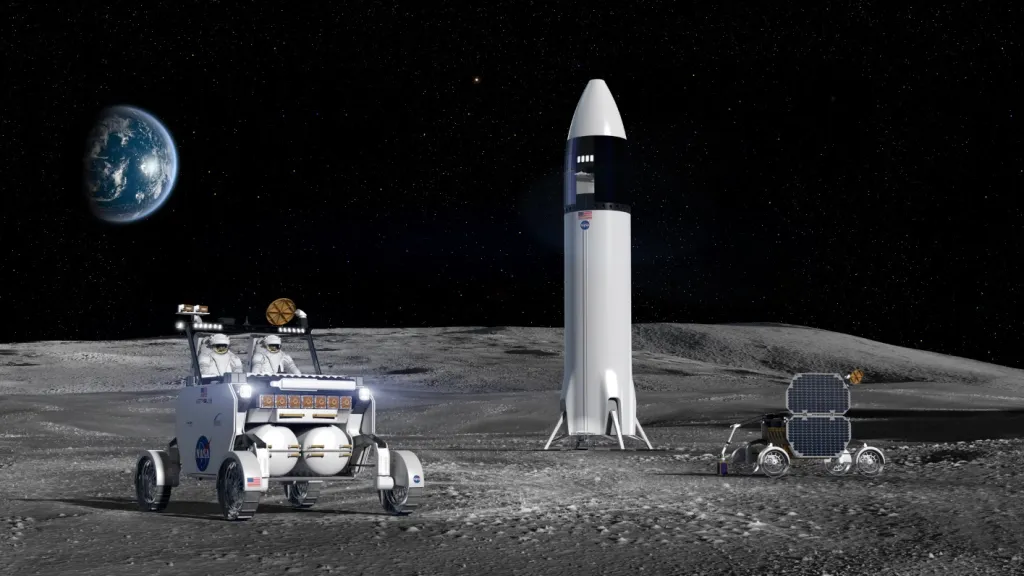NASA has officially announced its target year—2026—for the next manned mission to the Moon. This landmark spaceflight, part of the Artemis program, will mark the first time humans land on the lunar surface in over 50 years. The mission reflects the United States’ renewed commitment to space exploration and could open the door for long-term human presence on the Moon and eventually Mars.
Backed by billions in funding, international partnerships, and decades of research, NASA’s 2026 Moon mission is more than just a symbolic return. It represents a calculated step toward understanding the Moon’s environment, testing technologies, and preparing for future deep space exploration.
Read more about NASA’s Artemis program
Mission Overview: What Will the 2026 Moon Mission Accomplish?
The upcoming lunar expedition, known as Artemis III, will be the first mission under the Artemis program to land astronauts on the Moon. According to NASA officials, the crew will include both male and female astronauts, highlighting the agency’s goal to ensure diversity and inclusion in space.

The mission’s primary goals include:
- Landing astronauts near the Moon’s south pole.
- Conducting scientific research on lunar geology and ice deposits.
- Testing lunar surface mobility systems.
- Demonstrating advanced spaceflight capabilities and safety systems.
These objectives aim to lay the groundwork for sustainable lunar exploration and future missions to Mars.
Learn about previous Apollo landings
Why the Moon’s South Pole Matters
The 2026 mission is set to explore the Moon’s south pole, a region never visited by humans. This area is of great interest to scientists because it is believed to contain frozen water in permanently shadowed craters. Water is crucial not just for drinking, but also for producing fuel and oxygen—key components for long-duration space missions.
NASA hopes that by exploring this region, scientists can gain valuable insights into the Moon’s history and find resources that could support long-term missions.
The presence of water ice could make the Moon a useful base for launching deeper space missions, reducing the need to transport supplies from Earth.
Spacecraft and Launch Vehicles Involved
The mission will use several key components that are already undergoing testing:
- Orion spacecraft: Built by Lockheed Martin, it will carry astronauts to the Moon and back.
- Space Launch System (SLS): A powerful rocket that will launch Orion into space.
- Human Landing System (HLS): NASA has partnered with companies like SpaceX to develop this system. It will ferry astronauts from lunar orbit down to the surface and back.
All systems are being rigorously tested to meet the high safety standards required for human spaceflight.
Global Partnerships in the Mission
NASA is not working alone. The 2026 manned Moon mission is being developed in collaboration with international space agencies such as:
- European Space Agency (ESA)
- Canadian Space Agency (CSA)
- Japan Aerospace Exploration Agency (JAXA)
These agencies are contributing advanced technologies, robotic systems, and training expertise. ESA is providing the European Service Module for the Orion spacecraft, while CSA and JAXA are contributing to life-support and navigation systems.
Such collaborations emphasize that modern space exploration is a global endeavor, driven by shared goals of scientific discovery and peaceful exploration.
Timeline Leading to the 2026 Launch
NASA has already conducted key tests and missions leading up to Artemis III:
- Artemis I (2022): An uncrewed test flight around the Moon to evaluate the Orion spacecraft and SLS performance.
- Artemis II (Planned for 2025): The first crewed mission that will orbit the Moon but not land.
- Artemis III (Scheduled for 2026): The mission where astronauts will land on the Moon.
By progressing step by step, NASA is ensuring each component of the mission performs reliably before putting astronauts on the Moon.
What This Means for the Future of Space Travel
NASA’s Moon mission in 2026 is more than just an exploration milestone—it could change the future of space travel. By proving humans can live, work, and learn on the Moon, this mission could pave the way for a crewed Mars mission in the 2030s.
Technologies developed for Artemis—such as advanced life-support systems, lunar habitats, and in-situ resource utilization (ISRU)—can be adapted for longer missions to Mars and beyond.
The data collected will also help scientists study the effects of lunar gravity and radiation exposure on the human body.
Educational and Economic Impact
NASA’s ambitious return to the Moon is expected to inspire a new generation of scientists, engineers, and explorers. Educational outreach programs are already being rolled out in schools and colleges across the U.S. to spark interest in STEM fields.
The mission also has economic implications. Over 400,000 jobs across all 50 U.S. states are directly or indirectly supported by the Artemis program. Moreover, partnerships with private companies such as SpaceX, Blue Origin, and Boeing are creating a booming space economy projected to exceed $1 trillion by 2040.
Explore NASA’s STEM outreach initiatives
Conclusion: A Bold Step Toward a New Space Era
NASA’s 2026 manned Moon mission is a clear signal that humanity’s interest in deep space exploration is alive and growing. With a mix of cutting-edge technology, international collaboration, and bold scientific objectives, the Artemis III mission is set to redefine what’s possible in space exploration.
As the countdown to launch begins, all eyes will be on NASA and its partners. If successful, this mission will not only return humans to the Moon but also take a giant leap toward humanity’s future among the stars.
For more on the Artemis program and the upcoming mission:
Visit NASA’s official Artemis updates.
Also Read – Companies Are Changing Remote Work—See What’s Happening Now






